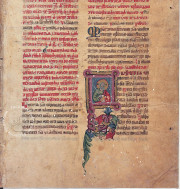Of the numerous missals written in the Croatian Church Slavonic language of the 14th and 15 centuries, the Hrvoje Missal deserves special mention. It represents the most beautiful and richly embellished illuminated codex of this group with precious miniatures of outstanding artistic quality. The text is written in the Church Slavonic language, with its typical angular Croat Glagolitic letters, a script still in use today in the liturgical books of the Croatian coastland on the northern Adriatic.
The sumptuous manuscript was made for a high-ranking personality, namely Hrvoje Vukcic Hrvatinic, duke of Split and governor of the provinces of Croatia, Dalmatia, and Bosnia, which were ruled by the Croat-Hungarian King Ladislas. The value of this manuscript must have been the reason for its turbulent destiny. Looted by the Turks, it was brought to the Sultan’s library at Constantinople. Later it was believed to be lost for a long time, until it was finally rediscovered in the Topkapi Sarayi Museum in 1963.
A total of 96 colourful miniatures and around 380 large ornamental initials among numerous smaller ones make this manuscript a unique work of art. The Hrvoje Missal is not only an essential work for philological, historical and liturgical research but also for the history of art and culture.
A Unique Testimony to Croatian Glagolitic Literature
According to an inscription contained in the book, the Hrvoje Missal was written out in Split by a resident calligrapher named Butko. He used the angular Glagolitic script whose invention has been ascribed to the two monks and Slavic apostles named Cyril and Methodius from Thessalonica. This script is based on Greek minuscules with elements borrowed from oriental alphabets and is still used today in services according to Roman use.
The Hrvoje Missal is one of the most important texts of Croatian Glagolitic literature, which had been banned over centuries, and was only to be re-established in 1248 by Pope Innocence IV. Based on its contents, it constitutes a so-called complete Missal, a form unified in the 13th century by the Franciscans on which all Croatian Glagolitic manuscripts were based.
A Sumptuous Decorative Apparatus
The 96 miniatures illustrate scenes from both the Old and the New Testaments, showing not only prophets, evangelists and apostles but also several saints with their attributes. Allegories of the months are depicted in characteristic scenes and incidents of life.
The miniatures contain both western elements and details of oriental and Byzantine origin. This allows us to locate the codex in southern Italy, in the close artistic circle of the Anjou dynasty whose realm then also included the area of Dalmatia and with whom Duke Hrvoje was in close contact. From southern Italy, where Byzantine monks and Christians from the eastern regions had found shelter from prosecution in the 8th and 9th centuries, the Byzantine oriental compositions infiltrated western iconography and subsequently the art of the Dalmatian coastland.
The initials, due to their imaginative decoration, attract the attention of the beholder. The bands, foliage and flowers forming the initials are ornate with clasps, nodes, linear motives, zoomorphic ornament such as heads of birds, serpents and snakes, and frequently even with anthropomorphic elements.
The particular value of the Hrvoje Missal lies in its combination of eastern and western principles in terms of composition and contents, thus making it a truly deluxe work and securing it a place in the regional and transregional history of art.
We have 1 facsimile edition of the manuscript "Hrvoje Missal": Missale Hervoiae Ducis Spalatensis croatico-glagoliticum facsimile edition, published by Akademische Druck- u. Verlagsanstalt (ADEVA), 1973
Request Info / Price

